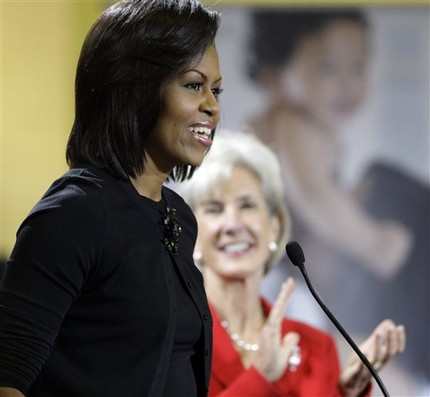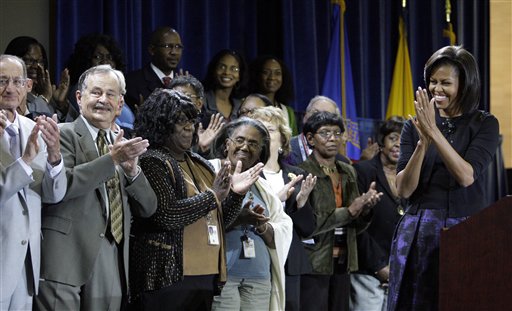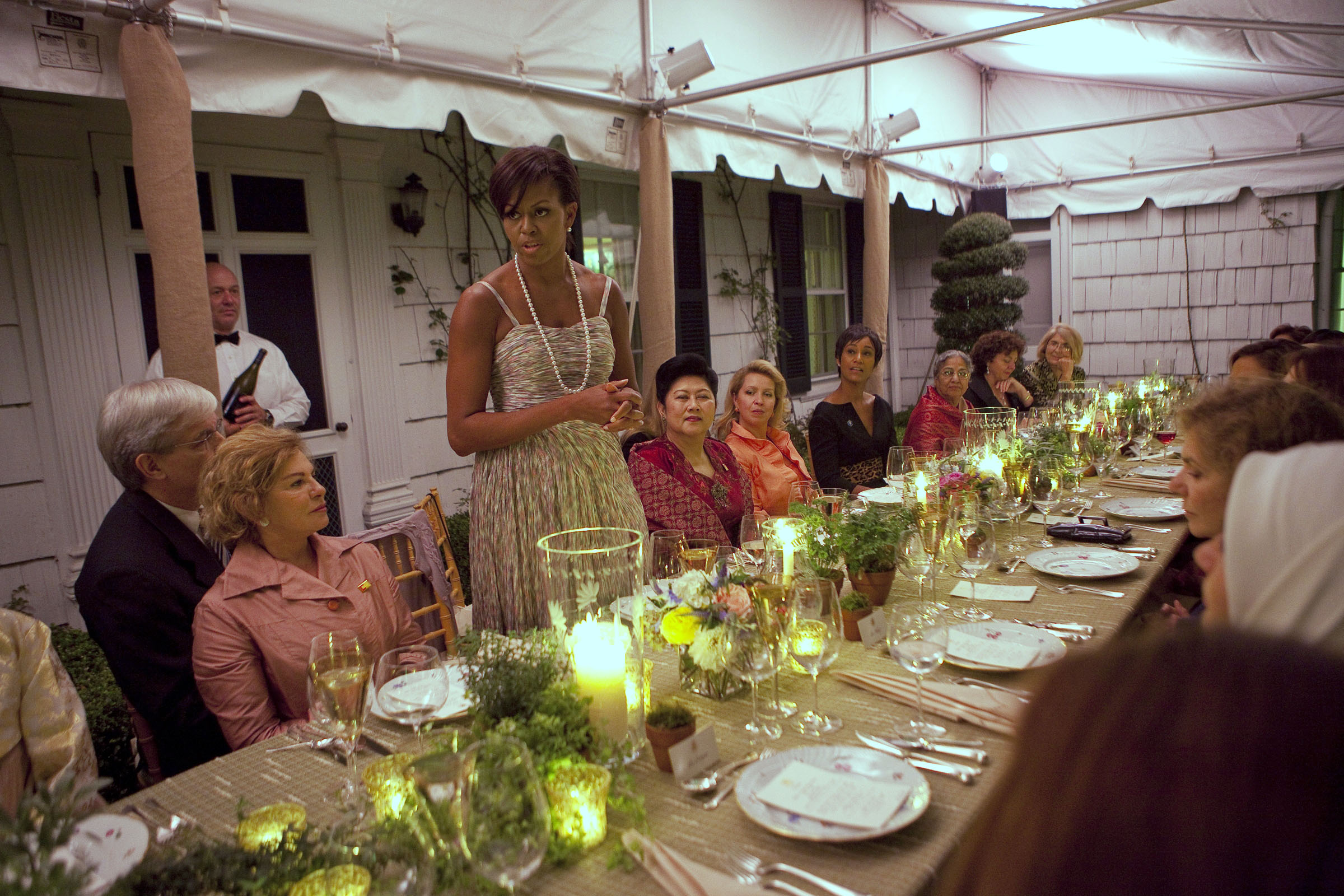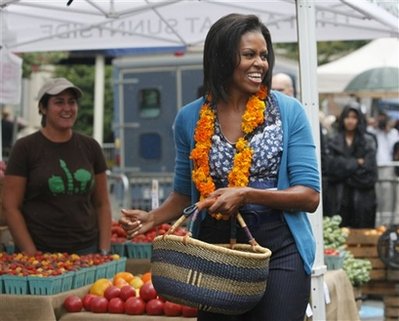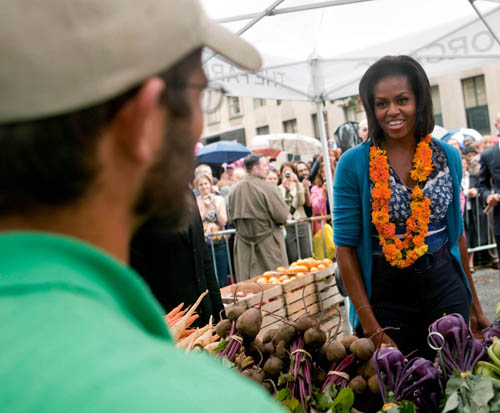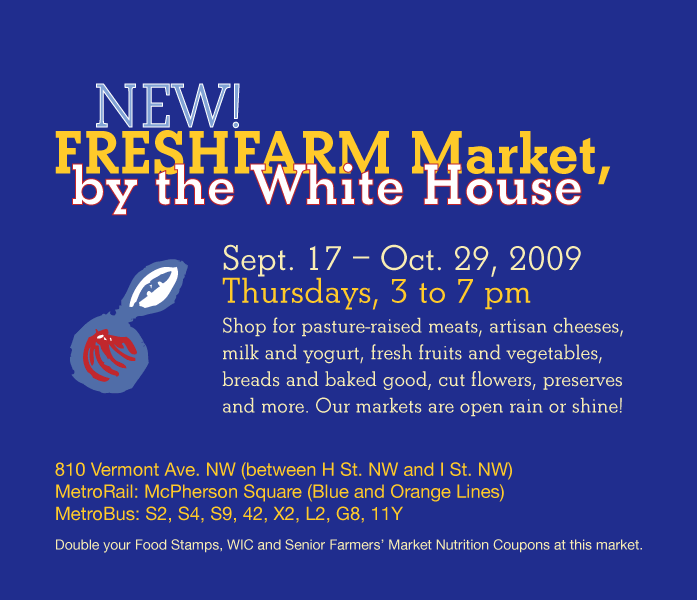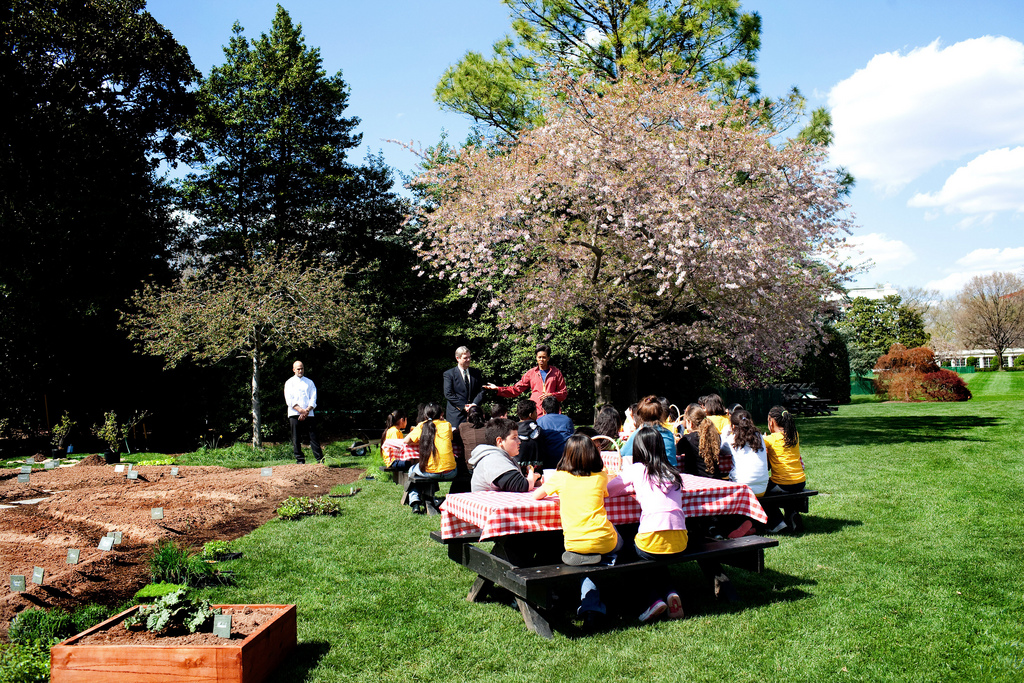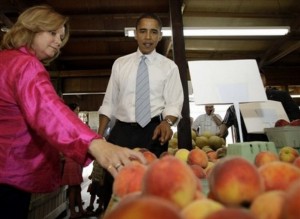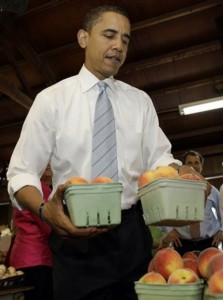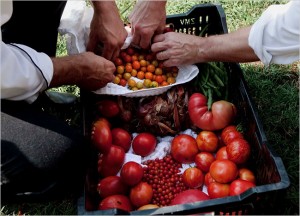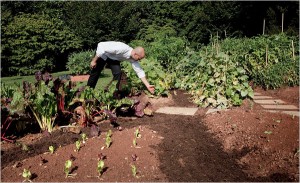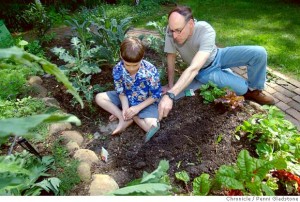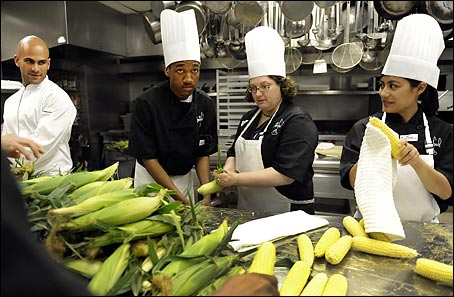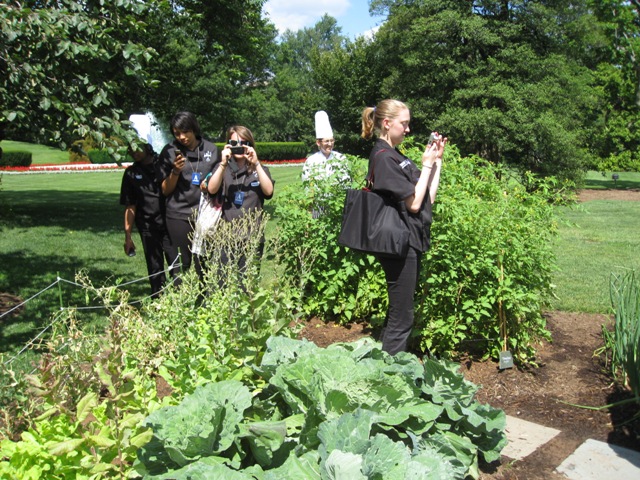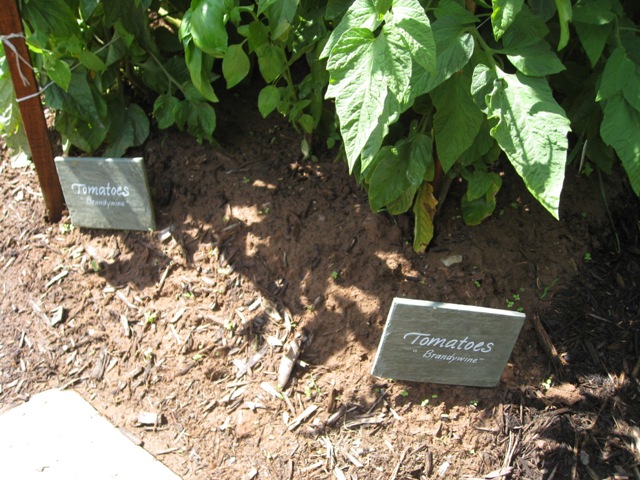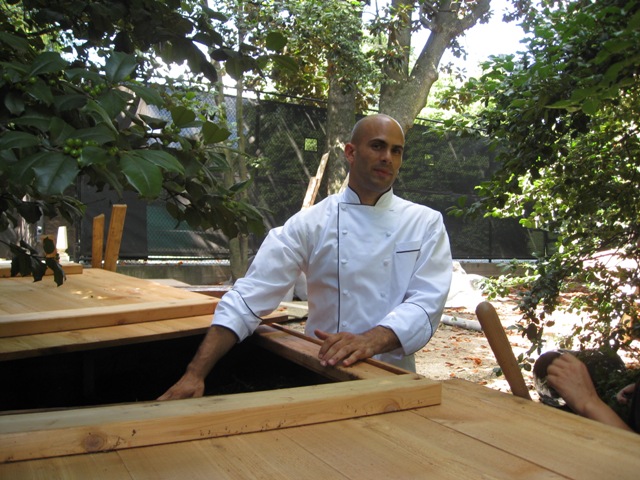First Lady at HHS: “Kids change quickly!”
Last week, ask Michelle Obama visited the Department of Health and Human Services.
One of the major focuses of her speech was healthy eating.
Towards the end, for sale she referereced the White House Kitchen Garden, and the impact it has had in changing the Bancroft kids’ relationship with food:
We can change the way that we see ourselves, our relationship with food and exercise, and we can pass on a whole ‘nother set of habits to our children. Their fate isn’t set yet. We still have everything in our power, because the other beautiful thing is that kids change quickly. Their habits are easily broken. They are so malleable, and they’re waiting for the right information, the right opportunities, and once they have it, they just go.
We’ve seen it with the children that we work with in the gardens. Many of the children in the public schools, they take this information, they understand it, they apply it to their lives, and they push their parents and their families to be different. That’s one of the reasons why we start with kids oftentimes. They are ready for change sometimes when we’re not.
The transcript follows, and as usual, you can read the analysis at Obama Foodorama.
Office of the First Lady
For Immediate Release
October 13, 2009
REMARKS BY THE FIRST LADY AT HHS AGENCY EVENT
Department of Health and Human Services
Washington, D.C.
2:15 P.M. EDT
MRS. OBAMA: Hey! (Applause.) Thank you. Thank you, all. Thank you so much. What a wonderfully warm welcome. I am just happy to be here. This is my first agency visit since we took a little break this summer, so this is the way to get back — started in the fall — coming to HHS.
I want to just thank Secretary Sebelius for that wonderful introduction. I think everyone can see that she hasn’t been giving — given a very easy portfolio. (Laughter.) You know, when you think about just sort of all that she’s had to deal with, and the grace and poise and intelligence that she’s brought to her position, we are all just grateful to have her on our team leading us, guiding us. And she is indeed a dear, dear friend, and I want to thank her for all of the work that she’s done — between health insurance reform, preparing for H1N1, and all the other critical issues that she’s laid out that HHS is working on that all of you are working on. I want to thank her and honor her for her work today. Let’s give her a round of applause. (Applause.)
But I am also here to thank and to honor all of you. It is something that I have enjoyed doing for the last nine and a half months that we’ve been in office, and that is to come around to the agencies, all the departments throughout Washington, and just to meet all of you and to make sure that you know, on behalf of the White House and our family, that we are so grateful for the work that you do.
We’re still new here. Nine and a half months — it feels longer — (laughter) — but we’re new. And when I come here, I come to listen, to ask questions, to use the information, the insight that I get from these visits, and take it back to the White House, to the West Wing, but also to help it inform the kinds of things that I do in my role as First Lady, because I know that many of you have spent a lifetime here devoting entire careers — some of you a few years, but many of you for decades — have spent your time devoted to the issues that are so important to this nation.
And in fact I think that there are few people behind us who have been working here at HHS for more than 40 or 50 years. (Applause.) And there is one gentleman in particular, Mr. Donald Abramson — where is Mr. Abramson? — who has been here for more than 60 years. (Applause.) And he still looks good. (Laughter.) Man, you know, I can’t imagine doing anything for 60 years. (Laughter.) But that’s why it’s so important for us to see all of you, and I want us to give everyone on this stage a round of applause for their dedication and commitment. (Applause.)
So we all know we have something to learn from the folks on this stage, right? But whether it’s fighting disease or promoting wellness; keeping our food and our drugs safe; protecting children and supporting families; or searching for the cures for the future; what you all do to help keep us healthy and strong is important — every single one of you.
And in many cases, it couldn’t be more urgent than now what you’re doing. And this is particularly true with an issue that I’ve taken on pretty vigorously and something that I want to just talk a little bit about today, and it’s an issue that doesn’t affect me just as First Lady but as a mother — and that is the growing threat of obesity, particularly childhood obesity, in this nation.
And I have pointed this out before, but right now — and I repeat this statistic everywhere I go — nearly a third of all children in this country are overweight or obese. One in three children in this country. And a third will suffer from diabetes at some point in their lifetimes. A third of children. And in the African American and Hispanic communities, that number goes up to one half. One half of those children.
This has profound implications for not just their futures but ours as a nation. It is a major public health threat right now, so just imagine what we’re going to be facing in 20 or 30 years if we don’t get on this issue. We have to think about what kind of increases we’ll be seeing in other obesity-related conditions like heart disease and cancer and high blood pressure. How much money will we be spending each year on the medical care, on the missed days of work, the loss of productivity? And how much will all of this diminish the quality of life for these children as they reach adulthood and then, you know, hopefully go on to sit where Mr. Abramson is sitting? (Laughter.) And what does it mean that medical experts are now warning that for the first time in the history of our nation — for the first time in the history of our nation — the next generation may be on track to having a shorter life span than this generation, than their parents?
And none of us wants a future like that for our children. All parents — and I don’t care what political party you belong to, what race, what part of the country you’re from — we all care about the health of our children, and we would do anything to ensure their health. Everyone wants to make sure their kids eat right. Everyone wants to make sure that their kids are getting enough activity. And everyone is working as hard as they can in their own homes.
But in many ways what I do know is that many families are starting to feel like the cards are stacked against them. It’s really hard to make sure that your children are healthy and happy and safe and well fed. And maybe it’s because some of — some folks are working on a tight budget, and they feel like they just can’t afford the kind of nutritious foods that are being recommended. Maybe it’s because folks are working long hours. Can I get an “Amen” from HHS?
AUDIENCE: Amen! (Laughter and applause.)
MRS. OBAMA: And they struggle to find time to make a home-cooked meal. Maybe they live in a community that doesn’t have access to a supermarket where there’s good fresh produce, and maybe the best thing that they have available is a food stand or a gas station or a convenience store to get their food. Or maybe there aren’t any safe places for kids to play, so it makes putting your kids in front of that Xbox a little more comforting and a little more of a better option.
Those of you who are parents, probably if you’re anything like me, you worry about this every single day. And many of you who are grandparents, who are in charge of things with your grandkids, are thinking about it.
And I know this feeling. You’ve had a long day at work — you know, I remember this two years ago before we got here. (Laughter.) While I was working and campaigning for my husband and trying to take care of two kids, I remember coming home from a meeting or from an event just tired — tired — (laughter) — and knowing that you’re going home to an empty refrigerator — (laughter) — and kids who are hungry — (laughter) — and fussy — (laughter) — and not wanting to eat anything you have in mind. (Laughter.) All they want is some pizza and some burgers, right? (Laughter.) And you don’t want to argue. You want a peaceful meal. (Laughter.) You want everyone to be quiet and just eat. (Laughter and applause.)
And it is in those moments — and for me there were many — where you just give in and just get that take-out. (Laughter.) Get them what they want. See “Drive-thru.” It’s like heaven. You drive through. (Laughter.) It’s quick, it’s easy.
As a mother of two little girls — and working mother at one time, in a job that gave me benefits — (laughter) — I can relate. And oftentimes eating out is the cheaper alternative in many cases.
So there was a time when I was living this life. And then I got a little tap on my shoulder from our kids’ pediatrician who basically said, “You know, you may want to look at changing the way your children are eating,” because he could see the effects. And I was shocked. I thought we all had our stuff together. (Laughter.)
But it’s a little startling when somebody tells you you need to, you know, rethink things. So you just try to figure out, well, where do you begin, what do you change, how can you change things? But what I found was that if we start small and not try to bite off too much, if we just added a few more fruits and vegetables into every single meal, if we cut down on sugary drinks and processed fruit — foods, that we could see some changes. And one of the things we tried not to ever do was be totally rigid; you know, just make kids so afraid of vegetables — (laughter) — that they would never, ever want to enjoy a meal.
But we worked on achieving moderation in our lives, teaching our kids about different types of foods, and what they do to their bodies, and eventually we got into a routine that worked for our family. And the biggest challenge was just figuring out where to start, and not letting it overwhelm you, or me. I’m talking to myself now. (Laughter.)
And I think a lot of families out there feel that way. They’d like to do things differently. They know there’s a problem. But when you’re already overwhelmed with so much, with work and bills and everything on your plate, it’s really hard to sort through all of the information that’s out there to figure out how do you fundamentally change things in a way that’s going to benefit your family.
But here’s this thing. So much research has been done on these issues. And a lot of it has been done by people who work right here. All of you have been working on these issues for so long. (Applause.) And part of the message that we’re trying to impart nationally is that parents, families don’t have to do this all by themselves. You know, they have all of you, they have all of us. We can offer them the tools and the information that they need to help them make the best decisions for their family.
That’s why Congress and the President included $1 billion for prevention and wellness programs in the Recovery Act –- (applause) — and that includes funding for initiatives that will give communities the resources they need to address the obesity epidemic in their communities. This includes $373 million announced last month that would be available for communities that put together comprehensive plans to reduce obesity –- $373 million — and that would include everything from incentivizing grocery stores to locate in underserved areas; it could include improving meals at school; to getting more healthy, affordable foods into vending machines; to creating more safe, accessible places for people to exercise and play; and a whole lot more.
But in the end, of course, our government and our communities, as you all know, we can only do so much. There’s only so much policy and even money can do. And no grant program can sit at the dinner table with a child, right, and convince them to eat what they’re supposed to eat. (Laughter.) But we say in my household, “Just eat it.” (Laughter.) “You’re not going to like it. Just finish it.” (Laughter.) “Get on with it.” (Laughter.) No grant program can make sure that the kids step away from the TV and set down those videogames and figure out a way to move their bodies. Ultimately all of that is up to parents and families. Ultimately we’re the ones who influence our kids.
But there’s good news: I’ve learned that, again, little changes can make a big difference. Little changes can make a big difference. Simply adjusting how we eat, like trying to cook one or two meals at home each week — not every week, that’s crazy — (laughter) — but one or two meals; switching from soda to water — pretty simple; adding a vegetable or a fruit to a dinner plate, making that more the meal than the meat or the rice; and paying a little more attention to what’s on the labels — again, not totally evaporating your way of being as you know it today, just little changes — and finding a way to get more exercise into all of our lives, including our kids. Walking instead of driving. Standing in front of the TV instead of sitting. (Laughter.) Small things. But all of this truly could have noticeable effects. (Laughter.) Small things. (Laughter.) All we’re saying.
But it isn’t easy to change old habits. That’s what we know. And it doesn’t happen all at once. It doesn’t happen overnight. But all of us want to live healthier lives. I know we all do. You don’t get pushback on this issue. We all want the best for our children. We just need the right information, and we need all of you.
The truth is, that’s why the work that you do is so important to this nation. And don’t ever forget that. The conversations that you can have — not just in your own families and your communities, but the communities that you work with, the folks that you come in contact through the work that you do — all of these little conversations, the steady drumbeat of small changes, make a difference.
So we’re going to need each and every one of you to stay pumped up, to stay healthy yourselves, which is why this program that the Secretary just mentioned, is a tremendous start. And I hope that every single one of the employees here takes advantage of it, because the best way to change your children’s lives is to see them watching you change yours, because in the end — (applause) — but this is an issue that we’re all going to need to work together on. And I am confident that we can begin to turn the tide on obesity.
We can change the way that we see ourselves, our relationship with food and exercise, and we can pass on a whole ‘nother set of habits to our children. Their fate isn’t set yet. We still have everything in our power, because the other beautiful thing is that kids change quickly. Their habits are easily broken. They are so malleable, and they’re waiting for the right information, the right opportunities, and once they have it, they just go.
We’ve seen it with the children that we work with in the gardens. Many of the children in the public schools, they take this information, they understand it, they apply it to their lives, and they push their parents and their families to be different. That’s one of the reasons why we start with kids oftentimes. They are ready for change sometimes when we’re not.
So I know that working together we can get this done. I want to thank you for your passion, for your commitment. It has been a pleasure to be here. I will be back soon. And get healthy! (Applause.) Thank you.
END
2:33 P.M. EDT






